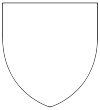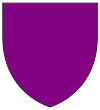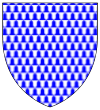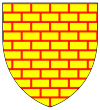BlazonIntro
Blazonry is a stylized jargon for describing coats of arms. In this site, we will be dealing with describing shields in particular, but blazonry also applies to the larger "achievement" of arms, including mottos, supporters, crests, etc.
The point of blazonry is to provide a description of a shield that is detailed enough to enable someone to draw a picture of it (maybe not a perfect one) that does not differ from the original in any "significant" way. The nature of "significant" of course relies on the rules of heraldry.
Blazonry has been compared to a primitive programming language, or maybe a markup language like HTML or a drawing language like PostScript or SVG would be closer. And indeed, that is what this project is all about: translating blazonry (or a subset thereof) into SVG.
This introduction to blazonry will be focussing on what pyBlazon can do, and even within that it will not be exhaustive. You'll have to learn more blazonry to explore more of the features of pyBlazon; I'm just giving you an idea so you can express some simple designs and understand some simple blazons. The blazonry taught here is specifically what pyBlazon can understand, but it is also (except for a few obvious features) valid, ordinary blazonry, so the blazonry skills you learn from these pages are applicable to blazonry you might see and describe to other people. All the examples shown have been rendered by pyBlazon.
A shield is always "blazoned" or described starting with the background, and working up in notional layers as charges are drawn on it and on each other. So the first thing in any blazon will be what the background of the shield looks like.
The simplest background is a solid color. The colors in blazonry have special names:
| Or | Argent | Sable | Gules | Azure | Vert | Purpure |
|---|---|---|---|---|---|---|
 |
 |
 |
 |
 |
 |
 |
Real mediæval heraldry uses the first five colors listed above more frequently by far than the others. Rarely does a single shield have more than three colors. There are some lesser-used tinctures that pyBlazon understands:
| Bleu Celeste | Tenne | Sanguine | Murrey | Rose | Copper |
|---|---|---|---|---|---|
 |
 |
 |
 |
 |
 |
News: as of pyBlazon release 307 (January 2009), you can also specify a color by using its “html” code, of the form #xxxxxx where each x is a hexadecimal digit, and the six digits specify the color with two digits each of red, green, and blue in that order. So you can get a cyan cross on a magenta field with #ff00ff a cross #00ffff.
There is a rule in heraldry that "metals" (Or and Argent) should not touch other metals, and "tinctures" (the other colors) should not touch other tinctures; i.e., metals only touch tinctures and vice-versa. But that rule starts to get strange when dealing with furs (see below), and it was not always observed even in mediæval times, so don't stress too much. pyBlazon won't care.
Other "solid" treatments of the field (or charges) are called "furs":
| Ermine | Ermines | Erminois | Pean | Vair |
|---|---|---|---|---|
 |
 |
 |
 |
 |
You can also generalize these patterns by saying things like Or ermined gules (for ermine-style furs) or Vairy or and sable (for vair-style). There are also some other variants of vair recognized, and other alterations you can do to the colors:
| Or ermined gules | Vairy or and sable | Counter-vair | Vair in pale | Or fretty gules | Or masoned gules |
|---|---|---|---|---|---|
 |
 |
 |
 |
 |
 |
See how to combine these on the PartyPer page, or if you don't want to get more complicated backgrounds but want to see how to place shapes on the background, look at the Ordinaries or Charges page.